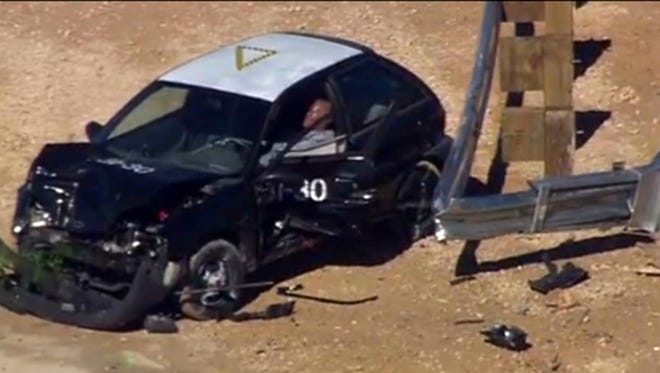Guardrail crash test failed, engineering expert says

NORFOLK, Va. — The end cap of a highway guardrail that's supposed to absorb energy from a crash failed the last of eight tests, penetrating the driver's side of a small car, according to a court document filed late Thursday.
The Federal Highway Administration mandated the tests after a federal jury in October found that Dallas-based Trinity Industries (NYSE: TRN), which makes the ET Plus guardrail end terminal, defrauded the federal government to the tune of $175 million by lying about a 2005 change in its product's design that has been linked to at least eight deadly accidents across the USA.
"The deformation of the driver's side door in the Jan. 27 crash test not only could have caused disabling injuries but showed a propensity to penetrate the vehicle and cause devastating injuries," said an engineering expert, Brian Coon, retained by a Virginia man who filed a federal whistle-blower lawsuit against Trinity.
Trinity started the tests Dec. 10 in San Antonio and concluded them last week. In an initial briefing after the end of the tests Jan. 27, Associate Administrator Tony Furst of the highway agency's Office of Safety said the test appeared to go as expected.
But Coon of Wichita, Kan., considers the Jan. 27 test as well as five tests between June 2005 and March 2006 to be a failure, he said in his affidavit.
"The flared ET Plus crash test failures and the Jan. 27 crash test failure are similar to failures occurring on the nation's roadways during collisions with the ET Plus terminal heads, which in many cases cause severe injuries and death," Coon said.
Joshua Harman of Swords Creek, Va., who helps run two companies that install and manufacture guardrail systems, filed the whistle-blower suit in 2012, according to Bloomberg News. He retained Coon.
Many states, including Virginia, have put out bids for contractors to identify and replace Trinity ET Plus guardrail end terminals; at least 42 states have stopped using the system. Virginia doesn't have a record of where each ET Plus system is installed.
In mid-December, Virginia's attorney general, Mark Herring, joined the whistle-blower lawsuit against Trinity Industries and a subsidiary, Trinity Highway Products LLC.
Less than 12 hours after news of Coon's affidavit was first reported early Friday, a spokesman for Trinity Industries released the results of the first four crash tests, which the Federal Highway Administration and an independent expert from Virginia Tech University said the guardrail end caps had passed.
"The ET Plus guardrail end-terminal system is a safe, effective roadside safety product," the company said in a statement. The tests were done on systems installed at a height of 27¾ inches, which it said are the vast majority on U.S. highways.
The second set of four tests, including the Jan. 27 test, were done on systems installed at a height of 31 inches.
The devices used during the tests have come under fire because they were taken from a California Department of Transportation warehouse where Trinity had shipped them in September and not from the side of a road, arousing suspicion that they are not made the same as what has been in use.
Measurements included in the Federal Highway Administration memo say five of the eight terminals had exit gaps larger than the 1 inch required in the design specifications.
The bigger the exit gap, the easier it is for the guardrail to protrude out of the end cap in the event of a collision. Critics have said the ET Plus is dangerous because it turns a guardrail into a spear that punches through cars when hit.
The end terminal involved in the Jan. 27 test, which Coon said had failed, had an exit gap of 1.04 inches, one of the most narrow gaps of the test batch.
During both the whistle-blower trial and later testing, Trinity Industries has maintained that its product is safe and that the company did not defraud the federal government.
Coon's affidavit was filed as part of a motion by Harman and his lawyers asking a judge to award penalties and attorney fees.